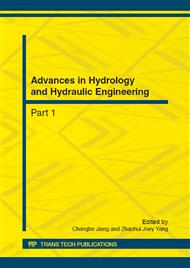p.759
p.765
p.772
p.780
p.789
p.796
p.801
p.805
p.810
Stability Experiment of Revetment Blocks for Regulation Project of Mulan Creek River
Abstract:
The anti-scour velocity of revetment blocks for flood control project of Mulan Creek river was studied through flume experiments. The results show that the revetment stability is related to the surface smoothness of revetment blocks. If they are paved smoothly, the incipient velocity of the blocks is greater than 4.0m/s, otherwise it is smaller than 3.2m/s. Hence, the smooth armour layer of revetment blocks are more stable than the others. According to distributions of flow velocities during flood in the river, the armor block types for different reaches of Mulan Creek river are suggested.
Info:
Periodical:
Pages:
789-795
Citation:
Online since:
October 2012
Authors:
Keywords:
Price:
Сopyright:
© 2012 Trans Tech Publications Ltd. All Rights Reserved
Share:
Citation:


